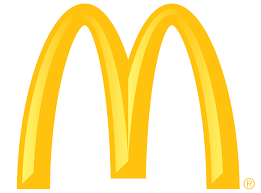This week, we learnt about logo and mascot design.
Logo Design
Contrary to popular belief, a logo is not a brand. It is instead a design that symbolises one's organisation.
Logos can be either purely graphic (symbols/icons) or are composed of the name of the organization (a logotype or wordmark). And as such, there are three different types of logo designs. They are either iconic/symbolic, logotypes/wordmarks, or combination marks.
Iconic/symbolic logos are efficient because they are instantly recognisable, as the images used are often easily eye-catching and memorable. When printed and produced in small sizes, an image is also more easily seen clearly, as opposed to words. Finally, they can also be illustrative in nature, and can be either concrete or abstract.
Here are some examples of well-known iconic/symbolic logos:

Source: http://speckycdn.sdm.netdna-cdn.com/wp-content/uploads/2011/05/30FamousLogos_30.jpg

Source: http://static.getkempt.com/photos/assets/lacostelogo_crop.jpg
A logotype/wordmark logo is an uniquely-styled type of font treatment. This type of logo is good because they are easily legible, and can ease recognition in the target audience. (Some interesting pointers to note:
Script fonts imply a sense of formality and refinement, thick fonts proclaim strength and power, while slanted fonts impart a sense of motion or movement.)
Some examples of logotypes/wordmarks:

Source: http://imgs.abduzeedo.com/files/paul0v2/minimalist-logotypes/logotype-01.jpg

Source: https://assets.mozillalabs.com/Brands-Logos/Firefox/wordmark-only/firefox_wordmark-only_RGB.png
Finally, there are the combination marks. These types of logos consists of concise text that can implement an icon or symbol, providing additional clarity. Combination marks can also be either integrated, or stand-alone, meaning the text can either be incorporated into the logo, or put beside the logo.
Here are some examples:

Source: http://socialventurepartners.org.s3.amazonaws.com/www.socialventurepartners.org/sites/40/2013/11/SVPlogo_Global-Combination_Black---Fill_RGB_600x127.png


Source: http://edss.weebly.com/uploads/1/3/2/3/13232001/6913283_orig.jpg
Besides learning about the different types of logos, we were also taught the 5 key principles in logo design, and that is the logos having to be simple, memorable,timeless, versatile and appropriate. With this in mind, we were then tasked to find 2 examples of good logo designs for each of the 3 different logo design types.
And I hereby present to you:
Iconic/symbolic: World Wildlife Foundation (WWF)

Source: http://artisanart.ro/wp-content/uploads/2011/02/13.jpg
This logo catches my eye because it is something that everybody knows: A panda. The design is classic, and that's just where its beauty lies in: Its simplicity and appropriateness. This logo is both appealing and memorable, and thus makes it very efficient.
Iconic/symbolic: McDonald's

Source: http://www.franchisingexpo.com.au/files/editor_upload/Image/McDonalds_logo[1].jpg
Speaking of classic designs, here's one that should be unfamiliar to nobody. The iconic logo of McDonald's has aged with us throughout our growing years, and yet remains ever-appealing and eye-catching. Simple and sweet, here is a true example of a timeless logo.
Logotype/wordmark:

Source: http://apex.aero/Portals/0/TVMC%20logos/Disney%20PSD%20Logo.png
The famous Walt Disney logo not only incorporates well-fitting font type with its theme of cartoon entertainment, it takes things one step further by using different colors for its logo, at different points of its existence, in order to constantly keep a "fresh" and memorable image. Shown here is just one of the many colors that the logo had used.
Logotype/wordmark:

Source:http://www.famouslogos.org/wp-content/uploads/2010/12/google1.jpg
Yet another famous logo, Google's wordmark incorporates much of what makes a successful and effective logo: Simplicity and memorable. Not to mention the name itself is funky and interesting, and the variety of colors used further amplifies the effect. All in all, a good logo that is able to stay etched into peoples' minds.
Combination mark:

Source: http://www.logodesignconsultant.com/images/Logo-types-example-combination-mark-logo-design.jpg
The bright colors used in Burger King's logo is appropriate indeed, as they signal a light and fun mood, which fits the idea of having a good time in this fast-food restaurant, enjoying a meal. The combination of the words and the logo does not feel awkward, and in fact makes it even more appealing and eye-catching, making for great effects on the target audience.
Combination mark:

Source: http://www.mdesignmedia.com/wp-content/uploads/Screen-shot-2013-09-23-at- 7.11.25-PM.png
Another simple and appropriate logo, it clearly show what the service or organisation is about, and will definitely appeal to their target audience.
Mascot Design
As earlier mentioned, we also learnt about mascot design. A mascot is a representative figure, a symbol and communication tool for somebody or some organisation/campaign/product. A mascot is aimed to personify their values, as well as to communicate effectively and help them to stand out from the crowd.
The qualities that make up a good mascot are as follows:
1) Connection to a company profession and values
2) Background story
3) Appeal
4) Style for target audience
5) Props and accessories
Having said that, here are some examples of good mascot designs:
M&M's

Source: https://blogger.googleusercontent.com/img/b/R29vZ2xl/AVvXsEj6Ct_TCQoW2v4l6OBgs-BBmra203-duZXEmLEr0VoFsxqWBkrRXIAgJtPmHpMBqCENnaVTrncdw5CAdHolbd7T-6Z5ZPs9nQtuXq7kLzHv36Dgrecmgs1GQ6dtlOaf2eh4w7qqeXFBV7GJ/s1600/mnm-mascot.jpg
2012 London Olympic's Mascot

Source: http://cdn2-b.examiner.com/sites/default/files/styles/image_content_width/hash/43/50/4350abedf2786c1d33434486620aa43d.jpg?itok=n21XdcVk
In conclusion, this week was very fruitful indeed. We learnt all about how good logos work, and how to make them. This is especially useful since our upcoming CA will be all about designing our very own logo and mascot. With my newly armed knowledge, I must say, I can't wait!





















